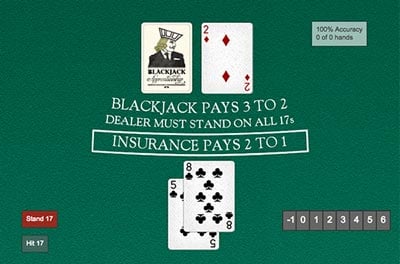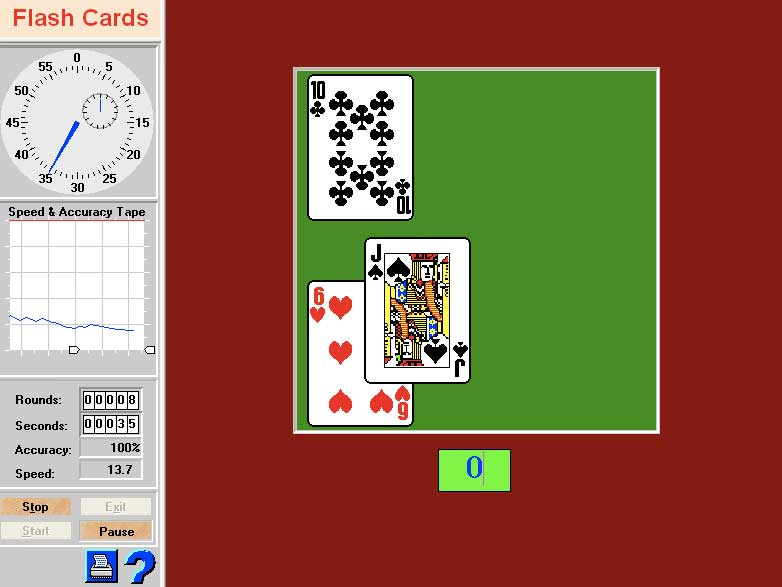Blackjack Apprenticeship Deviations
Posted By admin On 10/04/22
- Blackjack Apprenticeship Playing Deviations
- Blackjack Apprenticeship Deviations
- Blackjack Apprenticeship Deviations Chart
Blackjack Apprenticeship strategy If this is your first visit to the Blackjack Forum, be sure to check out the FAQ by clicking the link above. You will have to r e g i s t e r (free) before you can post: click the r e g i s t e r link to proceed. Playing Deviations are times when the true count dictates a decision that differs from Basic Strategy. Basic Strategy is the default correct playing decision for every possible hand combination in Blackjack. But as the Running and True Counts change, there are times that the ג€ correctג€ play also changes. When blackjack deviations concern how one bets at the blackjack table, these are known as betting deviations. Sometimes a change to the betting scheme can be a simple aspect of money management. Knowing how to properly use a betting bankroll is very important if one decides to make blackjack a serious endeavor.
Online Blackjack Strategy Trainer. The Blackjack Strategy Trainer is a free blackjack game that teaches basic strategy while you play. You select the exact rules that you want, and the Strategy Coach warns you if you make mistakes. If you wanna learn more about beating casinos with blackjack, you can subscribe to this YouTube channel, and you can also check out blackjackapprenticeship.com, where for 10 years now, we've been training people how to beat casinos legally with card counting for real money.
Blackjack Apprenticeship Playing Deviations
- Appendices
- Miscellaneous
- External Links
Introduction
Blackjack Apprenticeship Deviations
Rule variations will have an effect on the player's expected return. The numbers below show the effect on the player's return under various rules and after taking into consideration proper basic strategy adjustments. These changes are relative to the following rules: eight decks, dealer stands on soft 17, player may double on anyfirst two cards, player can double after splitting, playermay split to 4 hands.
Blackjack Apprenticeship Deviations Chart


Blackjack Rule Variations

| Rule | Effect |
|---|---|
| Blackjacks pay 2 to 1 | +2.27% |
| Triple down on any two cards | +1.64% |
| Five cardCharlie1 | +1.46% |
| Optional half win for 5-card Charlie9 | +0.77% |
| Suited blackjacks pay 2 to 1 | +0.57% |
| Player 21-points is automatic winner | +0.54% |
| Single deck | +0.48% |
| Early surrender against ace | +0.39% |
| Player 21 vs. dealer blackjack is a push | +0.35% |
| 5-card win pays 3-2 | +0.33% |
| Blackjack tie pays 3 to 2 | +0.32% |
| Six-card Charlie pays 3 to 2 | +0.31% |
| Early surrender against ten | +0.24% |
| 5-card (or more) 21 automatically pays 2 to 1 | +0.24% |
| Player may double on any number of cards | +0.23% |
| Ace and 10 after splitting aces is a blackjack (paying 3-2) | +0.21% |
| Player may draw to split aces | +0.19% |
| Double deck | +0.19% |
| Six card Charlie1 | +0.16% |
| Player may double, double for less, or stand after splitting aces | +0.15% |
| Tied blackjack pays 1-2 | +0.11% |
| Ace and 10 after splitting aces is a blackjack (paying 6-5) | +0.11% |
| Double Down Rescue | +0.10% |
| 6-card win pays 2-1 | +0.09% |
| Player may resplit aces | +0.08% |
| Player may double or stand after splitting aces | +0.08% |
| Late surrender against ten | +0.07% |
| Four decks | +0.06% |
| 7-card win pays 5-1 | +0.05% |
| 777 pays 3 to 1 automatically | +0.05% |
| Five decks | +0.03% |
| 777 pays 2 to 1 automatically | +0.03% |
| Six decks | +0.02% |
| Seven card Charlie1 | +0.01% |
| Late surrender against ace | +0.00% |
| Dealer must stop with six cards | +0.00% |
| Late surrender after splitting | +0.00% |
| Split to only 3 hands | -0.01% |
| No-peek: ace showing2 | -0.01% |
| BB+13 | -0.01% |
| Dealer secretly goes first5 | -0.02% |
| OBBO4 | -0.03% |
| European no hole card (splitting)7 | -0.03% |
| European no hole card (doubling)7 | -0.08% |
| Player may double on 9-11 only | -0.09% |
| No-peek: ten showing6 | -0.10% |
| Player may not resplit | -0.10% |
| European no hole card7 | -0.11% |
| Player may not double after splitting | -0.14% |
| Player may double on 10,11 only | -0.18% |
| Player may not split aces | -0.18% |
| Dealer hits on soft 17 | -0.22% |
| Blackkjack pays 7-5 | -0.45% |
| Player may not split | -0.57% |
| Red blackjack pays 2-1, Black blackjack pays 3-2, Mixed blackjack pays 1-1 | -0.57% |
| Blackjack pays 6-5 | -1.39% |
| Player may not double | -1.48% |
| Player loses 17 ties | -1.87% |
| Player may not double nor split | -1.91% |
| Blackjacks pay 1 to 1 | -2.27% |
| Player loses 17,18 ties | -3.58% |
| Player loses 17-19 ties | -5.30% |
| Dealer bust on 22 is a push8 | -6.91% |
| Player loses 17-20 ties | -8.38% |
| Player loses 17-21 ties | -8.86% |
Notes
- A 'Charlie' is an automatic winner. For example the five-card Charlie rule means the player automatically wins with 5 cards, as long as he didn't bust.
- Dealer does not peek for blackjack with an ace up. If dealer has a ace-up blackjack, player loses all bets made, including from doubling and splitting. A 10-up blackjack will be revealed immediately after peeking, and the player will lose only his original wager, except a blackjack tie will push.
- BB+1 refers to an Australian rule, in which the player will lose all busted bets, plus one unit, if the dealer gets a blackjack. For example, if the player splits 8's to three hands of a 20, (doubled) 19, and a busted hand, and the dealer get a blackjack, then the player will lose 2 units, one for the busted hand, and one from the remaining 3 units on the table. There is a great deal of confusion for the term for his rule, some sources calling it 'OBBO,' for Original and Busted Bets Only.
- OBBO stands for Original Bets and Busted Only. 'Original Bets' means each original bet per hand. So, if the player bet $5 and split to three hands, he would have three original bets of $5 each. As far as I know, the OBBO rule is confined to some parts of Australia and Malaysia. In the example above, the player would lose 3 units under this rule, one for the busted hand and two for the number of unbusted hands. The term is discussed in depth in the bookThe Pro's Guide to Spanish 21 and Australian Pontoon by Katarina Walker.
- This strange rule is actually followed in Pennsylvania, on Shufflemaster TMS-300 video multi-player blackjack games. State law prohibits one player taking the cards of another player. The way they implement this rule is to give every player, and the dealer, a separate shoe. The dealer plays out his hand first, secretly, and the results stored in memory. Then the cards used by the dealer are removed for each player shoe. When all players have finished acting, the game shows what cards the dealer drew already. According to Shufflemaster, the effect of this rule is 0.02% in favor of the dealer. Shufflemaster wishes to add this rule is part of a patent-pending technology.
- Dealer does not peek for blackjack with a 10 up. If dealer has a 10-up blackjack, player loses all bets made, including from doubling and splitting. An ace-up blackjack will be revealed immediately after peeking, and the player will lose only his original wager, except a blackjack tie will push.
- Dealer does not take a hole card, or never peeks at it if he does. If the dealer has a blackjack, then player loses all bets made, including from doubling and splitting, except a blackjack tie will push. The cost of this rule to the player is 0.08% when doubling, and 0.03% when splitting. This breakdown is important in the case of Galaxy casinos in Macau, where the player only loses the original bet when doubling, but everything when splitting, if the dealer gets a blackjack.
- The push on a dealer 22 rule is a legally protected rule. The rights belong to the owner of Blackjack Switch.
- This rule can be found at the Pharaoh's Palace in Macau. The player may invoke the rule before the dealer checks for blackjack. The effect shown is based on the dealer not taking a hole card.
Written by: Michael Shackleford